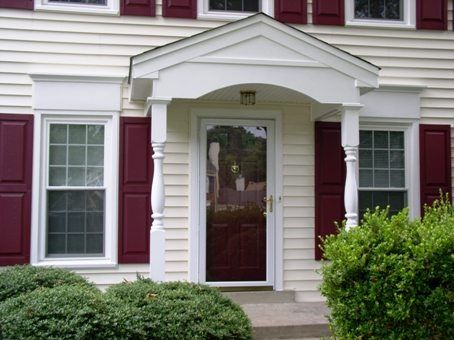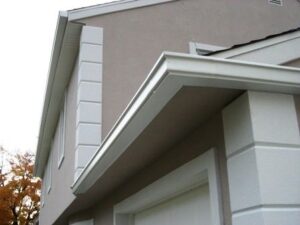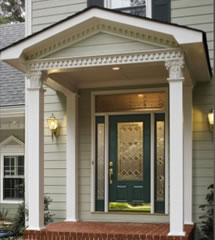Exterior trim contributes both beauty and function to the outside of your home. Not only does it provide waterproofing protection around windows, doors, and at corners, it can also dramatically improve the appearance and curb-appeal of your home. When added to a siding replacement, it provides the perfect finishing touch for an exquisite exterior.

Why Do I Need New Exterior Trim?
Here are the main reasons to consider adding or replacing exterior house trim:
Preventative Siding Maintenance
All types of siding, especially wood, are susceptible to rot and decay from moisture. Exterior trim takes the brunt of exposure to the elements and will show the first warning signs of deterioration. Failure to take prompt action to replace worn exterior trim can result in a higher repair bill or possibly a siding replacement.
Improve Curb-Appeal
The first thing homeowners generally think of when wanting to increase the curb-appeal of their home is exterior painting. However, painting can be expensive, time-consuming, and difficult. For a quick, yet affordable face-lift, replace your home’s exterior trim instead of painting. Many of today’s trim options come pre-primed and/or pre-painted saving you both time and money.
What Type of Exterior Trim is Right for Me?
When considering adding or replacing exterior house trim, you should look for a product that is durable, weather-resistant, physically stable, and aesthetically pleasing. Fortunately, recent advances in building materials technology have provided homeowners with a plethora of choices which range in cost, functional features, and beauty.
Today, homeowners are seeking low-maintenance exteriors. Thanks to modern technology there are many products available which can be grouped into three categories: vinyl, PVC, and fiber cement.
Vinyl Trim
Many builders use wood trim when constructing a new home. This cheap contractor grade trim quickly deteriorates, rots, or needs repetitive repainting. To solve the myriad of issues with wood exterior trim, vinyl trim has risen to the forefront as a popular wood trim alternative. You probably already know that vinyl siding, flooring, doors, and windows are popular building products that perform well at a great value. However many homeowners don’t realize that vinyl exterior trim also offers a number of benefits.
Vinyl Trim is highly durable making for great longevity. The vinyl material is very flexible, making it easy to fit arches, curves, and unusual trim shapes. It’s not susceptible to water damage such as rot, mold, mildew, warping, cracking, delimination, etc. It’s also resistant to insect damage such as termites, etc. Perhaps best of all, vinyl trim is virtually maintenance-free.
PVC Trim
PVC stands for polyvinyl chloride… which is basically a plastic. And although at first, the sound of “plastic trim” on one’s house may not sound very inviting, PVC trim offers several desirable attributes that are making it one of today’s more popular alternatives.
Because PVC trim is plastic in nature, it is obviously impervious to moisture and insects. And although it is not necessary for protection, PVC trim does accept paints and stains. Thanks to modern UV inhibitors, PVC trim won’t yellow over time. And, as with most plastic products, PVC trim is easy to clean.
Fiber-Cement Trim
Fiber-cement siding has gained a good reputation for its resistance to fire and rot, and its use is growing rapidly. Until recently, however, fiber-cement trim products have been limited to thin materials — generally between 1/4 and 1/2 inch thick. Several manufacturers make conventional fiber-cement trim products in thicknesses ranging from 1/4 inch to 1/2 inch. These thinner materials can be used for soffits and fascias. Recently, thicker products have become available as well for other trim applications. Fiber-cement does not expand or contract significantly with changes in humidity or temperature, so the material holds paint well.
Fall is an ideal time to inspect your home’s exterior trim. Walk around your house and look at the trim around your windows and doors, at the corners, and near the roofline. Warning signs of potential problems include peeling or blistering paint, mold and mildew, warped boards, and spongy or soft spots. Check for termite damage too; they cause more damage to U.S. homes than fire, floods and storms combined!
If the trim is damaged beyond repair, the only solution is replacement. Depending on your carpentry skills, replacing exterior trim could possibly be a do-it-yourself project, however it is really best to hire a professional. The extra dollars it costs you to hire a professional now will likely save you many thousands of dollars down the road. Look for a firm with a roster of happy customers and you won’t go wrong.
Here at American Windows & Siding of VA, Inc., we enjoy helping people. If you have any questions about vinyl trim, vinyl soffit, vinyl siding, James Hardie fiber cement siding, or siding replacement questions of any kind … feel free to contact us anytime and we’ll do our best to answer all your questions!



